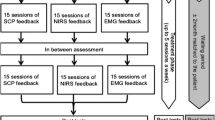Abstract
For nearly 25 years, EEG biofeedback (neurofeedback) has been utilized in research and clinical settings for the treatment and investigation of a number of disorders ranging from attention deficit hyperactivity disorder to seizure disorders as well as many other established and investigational applications. Until recently, mechanisms underlying the generation and origins of EEG have been poorly understood but now are beginning to become much more clarified. Now it is important to combine the information gathered on the genesis of EEG and neocortical dynamics with the findings from neurofeedback investigations. This will help us to develop models of how neurofeedback might operate in producing the changes in EEG and in clinical symptomatology. We know that the cortex operates in terms of resonant loops between neocortical columns of cells known as local, regional, and global resonances. These resonances determine the specific EEG frequencies and are often activated by groups of cells in the thalamus known as pacemakers. There are complex excitatory and inhibitory interactions within the cortex and between the cortex and the thalamus that allow these loops to operate and provide the basis for learning. Neurofeedback is a technique for modifying these resonant loops, and hence, modifying the neurophysiological and neurological basis for learning and for the management of a number of neurologically based disorders. This paper provides an introduction to understanding EEG and neocortical dynamics and how these concepts can be used to explain the results of neurofeedback training and other interventions particularly in the context of understanding attentive mechanisms and for the management of attention deficit/hyperactivity disorders.
Similar content being viewed by others
REFERENCES
Amen, D. A., Paldi, J. H., & Thistead, R. A. (1993). Evaluating with brain SPECT imaging. Paper presented at the meeting of the American Psychiatric Association.
Andersen, P., & Andersson, S. A. (1968). Physiological Basis of the Alpha Rhythm. New York: Meredith Corporation.
Hebb, D. O. (1949). Organization of behavior: A neuropsychological theory. New York: Wiley.
Henriques, J.B., & Davidson, R. J. (1991). Left frontal hypoactivation in depression. Journal of Abnormal Psychology, 100, 534–545.
Krieg, W. J. S. (1963). Connections of the cerebral cortex. Evanston, IL: Brain Books.
Krieg, W. J. S. (1973). Architectronics of the human cerebral fiber systems. Evanston, IL: Brain Books.
Lou, H. C., Henriksen, L., & Bruhn, P. (1984). Focal cerebral hypoprofusion in children with dysphasia and/or attention deficit disorder. Archives of Neurology, 41, 825–329.
Lubar, J. F. (1991). Discourse on the development of EEG diagnostics and biofeedback treatment for attention deficit/hyperactivity disorders. Biofeedback and Self-Regulation, 16, 201–225.
Lubar, J. F., & Deering, W. M. (1981). Behavioral approaches to neurology. Academic Press.
Lubar, J. F., Swartwood, M. O., Swartwood, J. N., & O'Donnell, P. (1995a). Evaluation of the effectiveness of EEG neurofeedback training for ADHD in a clinical setting as measured by changes in T.O.V.A. scores, behavioral rating, and WISC-R performance. Biofeedback and Self-Regulation, 20, 83–99.
Lubar, J. F., Swartwood, M. O., Swartwood, J. N., & Timmermann, D. L. (1995b). Quantitative EEG and auditory event-related potentials in the evaluation of Attention-Deficit/Hyperactivity disorder: Effects of methylphenidate and implications for neurofeedback training. Journal of Psychoeducational Assessment (Monograph Series Advances in Psychoeducational Assessment) Assessment of Attention-Deficit/Hyperactivity Disorders, 143–204.
Martin, J. H. (1991). The collective electrical behavior of cortical neurons: The electroencephalogram and the mechanisms of epilepsy. In E. R. Kandel, J. H. Schwartz, & T. M. Jessell (Eds.), Principles of Neural Science (pp. 777–791). New York: Elsevier.
Matochik, J. A., Liebenauer, L. L., King, A. C., Szymanski, H. V., Cohen, R. M., & Zametkin, A. J. (1994). Cerebral glucose metabolism in adults with attention-deficit hyperactivity disorder after chronic stimulant treatment. American Journal of Psychiatry, 151, 658–664.
Morison, R. S., & Basset, D. L. (1945). Electrical activity of the thalamus and basal ganglia in decorticate cats. Journal of Neurophysiology, 8, 309–314.
Nunez, P. L. (1995a). Toward a physics of neocortex. In P. L. Nunez (Ed.), Neocortical Dynamics and Human EEG Rhythms (pp. 68–132). New York: Oxford University Press.
Nunez, P. L. (1995b). Mind, brain, and electroencephalography. In P. L. Nunez (Ed.), Neocortical Dynamics and Human EEG Rhythms (pp. 133–194). New York: Oxford University Press.
Pilgreen, K. L. (1995). Physiologic, medical, and cognitive correlates of electroencephalography. In P. L. Nunez (Ed.), Neocortical Dynamics and Human EEG Rhythms (pp. 195–248). New York: Oxford University Press.
Posner, M. I., & Raichle, M. E. (1994). Images of mind. New York: Scientific American Library.
Rasey, H. W., Lubar, J. E., McIntyre, A., Zoffuto, A. C., & Abbot, P.L. (1996). EEG Biofeedback for the enhancement of attentional processing in normal college students. Journal of Neurotherapy, 1, 15–31.
Schwartz, M.S. (1995). Biofeedback: A practitioner's guide. NY: Guilford.
Silberstein, R. B. (1995). Neuromodulation of neocortical dynamics. In P. L. Nunez (Ed.), Neocortical Dynamics and Human EEG Rhythms (pp. 591–627). New York: Oxford University Press.
Steriade, M., Gloor, P., Llinas, R. R., Lopes da Silva, F. H., & Mesulam, M. M. (1990). Basic mechanisms of cerebral rhythmic activities. Electroencephalogr. Clin. Neurophysiol., 76, 481–508.
Szentágothai, J. (1969). Architecture of the cerebral cortex. In H. H. Jasper, A. A. Ward, Jr. and A. Pope (Eds.), Basic Mechanisms of the Epilepsies (pp. 13–28). Boston: Little, Brown.
Author information
Authors and Affiliations
Rights and permissions
About this article
Cite this article
Lubar, J.F. Neocortical Dynamics: Implications for Understanding the Role of Neurofeedback and Related Techniques for the Enhancement of Attention. Appl Psychophysiol Biofeedback 22, 111–126 (1997). https://doi.org/10.1023/A:1026276228832
Issue Date:
DOI: https://doi.org/10.1023/A:1026276228832




